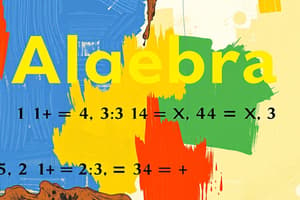Podcast
Questions and Answers
What is Algebra?
What is Algebra?
- An ancient form of counting.
- A system only for whole numbers.
- A type of geometry.
- A system that uses letters to represent unknown numbers and variables. (correct)
What does the Associative Property state?
What does the Associative Property state?
The way in which numbers are grouped does not change their sum or product.
What is the definition of Base in mathematics?
What is the definition of Base in mathematics?
The number on which a place value system is built; our decimal system is base 10.
What does the Commutative Property state?
What does the Commutative Property state?
What is an Exponent?
What is an Exponent?
What are Factors?
What are Factors?
What does Factoring mean?
What does Factoring mean?
What is the Greatest Common Factor (GCF)?
What is the Greatest Common Factor (GCF)?
What is a Reciprocal?
What is a Reciprocal?
What is Absolute Value?
What is Absolute Value?
Define Composite Numbers.
Define Composite Numbers.
What is the Least Common Multiple (LCM)?
What is the Least Common Multiple (LCM)?
What are Square Roots?
What are Square Roots?
What is a Binomial?
What is a Binomial?
What are Counting Numbers?
What are Counting Numbers?
Define Integers.
Define Integers.
What are Irrational Numbers?
What are Irrational Numbers?
What are Natural Numbers?
What are Natural Numbers?
What is Perimeter?
What is Perimeter?
What is a Polynomial?
What is a Polynomial?
Define Rational Numbers.
Define Rational Numbers.
What are Real Numbers?
What are Real Numbers?
What is a Trinomial?
What is a Trinomial?
What are Whole Numbers?
What are Whole Numbers?
What does the Distributive Property state?
What does the Distributive Property state?
What is Analytic Geometry?
What is Analytic Geometry?
Define Cartesian Coordinate System.
Define Cartesian Coordinate System.
What is a Line in mathematics?
What is a Line in mathematics?
What is Magnitude in a mathematical context?
What is Magnitude in a mathematical context?
What is the Origin in a Cartesian plane?
What is the Origin in a Cartesian plane?
What does the Pythagorean Theorem describe?
What does the Pythagorean Theorem describe?
What is a Quadrant in the coordinate plane?
What is a Quadrant in the coordinate plane?
What is a Resultant Vector?
What is a Resultant Vector?
What is a Vector?
What is a Vector?
What is the X-axis?
What is the X-axis?
What is the Y-axis?
What is the Y-axis?
What is the X-intercept?
What is the X-intercept?
What is the Y-intercept?
What is the Y-intercept?
What is Slope?
What is Slope?
Flashcards are hidden until you start studying
Study Notes
Algebra Concepts
- Algebra represents unknown numbers and variables using letters, operating under base x.
- Associative Property dictates that changing the grouping of numbers does not alter their sum or product.
- Base refers to the foundational number system, with our decimal system being base 10.
- Commutative Property states that the order of addition or multiplication does not affect the result.
- Exponents indicate how many times a number is multiplied by itself.
- Factors are numbers multiplied together to yield a product.
- Factoring involves identifying the factors of a specific number.
- Greatest Common Factor (GCF) is the largest number that evenly divides two or more numbers.
- Reciprocals are fractions that multiply to yield one, e.g., the reciprocal of N/D is D/N.
Number Types and Properties
- Absolute Value describes the distance of a number from zero, expressed as a positive value.
- Composite Numbers are whole numbers greater than 1 that possess more than two factors.
- Least Common Multiple (LCM) identifies the smallest common multiple of two or more numbers.
- Square Roots are numbers that, when multiplied by themselves, yield a square (e.g., 3 is the square root of 9).
- Binomials are algebraic expressions containing exactly two terms.
- Counting Numbers, also known as natural numbers, start from 1 and progress sequentially (1, 2, 3…).
- Integers encompass both positive and negative counting numbers, as well as zero.
- Irrational Numbers cannot be expressed as a ratio of integers and have non-ending, non-repeating decimal expansions.
- Natural Numbers are equivalent to counting numbers.
- Perimeter calculates the total distance around a two-dimensional figure.
- Polynomials consist of algebraic expressions with more than one term.
- Rational Numbers include all integers, fractions, and decimal values, both positive and negative.
- Real Numbers consist of all rational and irrational numbers.
Advanced Algebra Topics
- Trinomials are polynomials that contain three terms.
- Whole Numbers encompass counting numbers and zero.
- Distributive Property allows a common factor to be distributed across terms in an equation, such as a(b + c) = ab + ac.
Geometry and Coordinate Systems
- Analytic Geometry integrates algebraic concepts onto geometric graphs.
- The Cartesian Coordinate System, named after René Descartes, utilizes X and Y axes for graphing.
- A Line is defined as an infinite collection of connected points.
- Magnitude refers to the size or strength of a measurement.
- The Origin is the intersection point of the X and Y axes, serving as the starting point of a ray.
- The Pythagorean Theorem relates the lengths of the legs and hypotenuse in a right triangle.
- Quadrants divide the coordinate plane into four sections for graphing.
- Resultant Vectors represent the vector sum of multiple vectors.
- Vectors are measurements characterized by both direction and magnitude.
- The X-axis is the horizontal line in a coordinate plane.
- The Y-axis is the vertical line in a coordinate plane.
Intercepts and Slope
- The X-intercept is the point where a line intersects the X-axis.
- The Y-intercept is the point where a line intersects the Y-axis.
- Slope is calculated as the rise over run and is typically represented by the letter m.
Studying That Suits You
Use AI to generate personalized quizzes and flashcards to suit your learning preferences.




